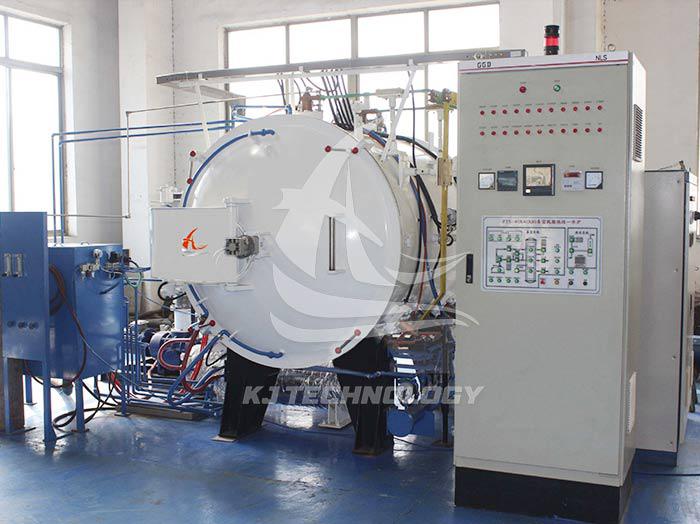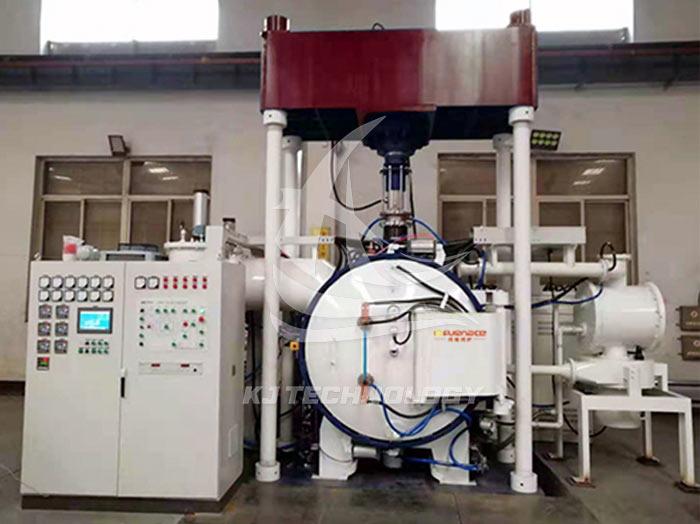Daily maintenance of diffusion welding vacuum furnace
 08-18-2025 Author: KJ technology
08-18-2025 Author: KJ technology
The daily maintenance of diffusion welding vacuum furnace should revolve around four core areas: vacuum system, heating system, pressure system, furnace body cleaning, and safety protection. The specific operating points are as follows:
1. Vacuum system maintenance
Vacuum pump maintenance
Oil level inspection: Check the oil level of the mechanical pump daily to ensure that it is at 1/2~2/3 of the oil window. If the oil level is too low, special vacuum pump oil (such as vacuum pump oil No. 3) should be added in a timely manner.
Oil quality replacement: Replace the vacuum pump oil every 3-6 months. When changing the oil, completely drain the old oil and check for wear or foreign objects (such as metal shavings and oxide scales) inside the pump body.
Operation monitoring: Check the operation sound and temperature of the vacuum pump daily. Abnormal noise or high temperature (>70 ℃) may indicate foreign objects or component wear inside the pump, and the machine needs to be stopped for maintenance.
Vacuum pipelines and valves
Sealing test: Every 6-12 months, use a helium leak detector to test pipeline interfaces, valves, and other parts. Leakage points should be repaired in a timely manner (such as replacing sealing rings or re tightening flanges).
Valve maintenance: Regularly clean the dirt inside the valve, check whether the seals (such as O-rings) are worn, and replace them if they are severely worn (recommended to use Buna-N, silicone or Viton materials).
Vacuum degree maintenance: After shutdown, the vacuum degree inside the furnace should be maintained at ≤ 6.65 × 10 ⁴ Pa to prevent humid air from entering and causing oxidation or pollution.
2. Heating system maintenance
Heating element inspection
Graphite heater: Check the graphite heating element for breakage, wear, or surface oxidation every 3-6 months. If damaged, replace it promptly to avoid affecting heating uniformity.
Tighten connection: Check if the heating element terminals are clamped tightly. If they are loose, tighten the connecting screws again to prevent poor contact from causing local overheating.
Temperature control system calibration
Thermocouple testing: Check the accuracy of temperature measurement of thermocouples, thermal resistors, etc. every 6-12 months. Resistance measurement or comparison with standard temperature testing can be used. If the error exceeds the standard, calibration or replacement is required.
Controller calibration: If the temperature controller displays abnormalities, it needs to be recalibrated or replaced to ensure temperature control accuracy of ≤± 5 ℃.
3. Pressure system maintenance
Hydraulic/pneumatic device inspection
Pressure stability: Check the pressure gauge reading daily to ensure that the pressure fluctuation is ≤ ± 0.5MPa. If there are any abnormalities, check the hydraulic pump or air source.
Seal replacement: Regularly inspect the pressure system seals (such as seals and O-rings), and replace them in a timely manner if they are worn or aged to prevent pressure leakage.
Lubrication of mechanical transmission components
Lubrication cycle: Add lubricating oil (such as No. 46 anti-wear hydraulic oil) to mechanical transmission components (such as hydraulic cylinders and pneumatic rods) every 1-3 months to reduce wear and extend service life.
Oil filtration: Lubricating oil needs to be strictly filtered before being added to the oil tank to prevent impurities from entering and causing blockage or inaccurate limit.
4. Furnace cleaning and safety protection
External cleaning of furnace body
Daily wiping: Use a clean cloth to wipe the outside of the furnace body daily, remove dust, oil stains and other impurities, and focus on cleaning the sealing area of the furnace door to prevent impurities from affecting the sealing effect.
Observation window cleaning: Regularly clean the observation window on the furnace body, use specialized glass cleaner to remove stains, and ensure that the situation inside the furnace is clear and visible.
Internal cleaning of furnace
Residual removal: After each batch of welding is completed, remove impurities such as oxide scale and solder splatter from the furnace bottom to prevent contamination of subsequent workpieces.
Moisture proof treatment: If the furnace is exposed to a humid environment for a long time, it needs to be dried in an oven (such as holding at 100 ℃ for 2 hours) to remove adsorbed moisture.
Safety protection measures
Environmental requirements: The equipment should be placed in a clean, dust-free, and non corrosive gas room, with an ambient temperature controlled between 10-30 ℃ and humidity ≤ 60%.
Antifreeze protection: In winter, it is necessary to ensure that the indoor temperature is above 10 ℃ to prevent the cooling water pipeline from freezing and cracking (spare water pipelines can be added).
Electrical safety: Regularly check the insulation resistance of equipment (≥ 1000 Ω). If the resistance is too low, check the resistance of electric heating elements, electrodes, and insulation layers to prevent leakage.








